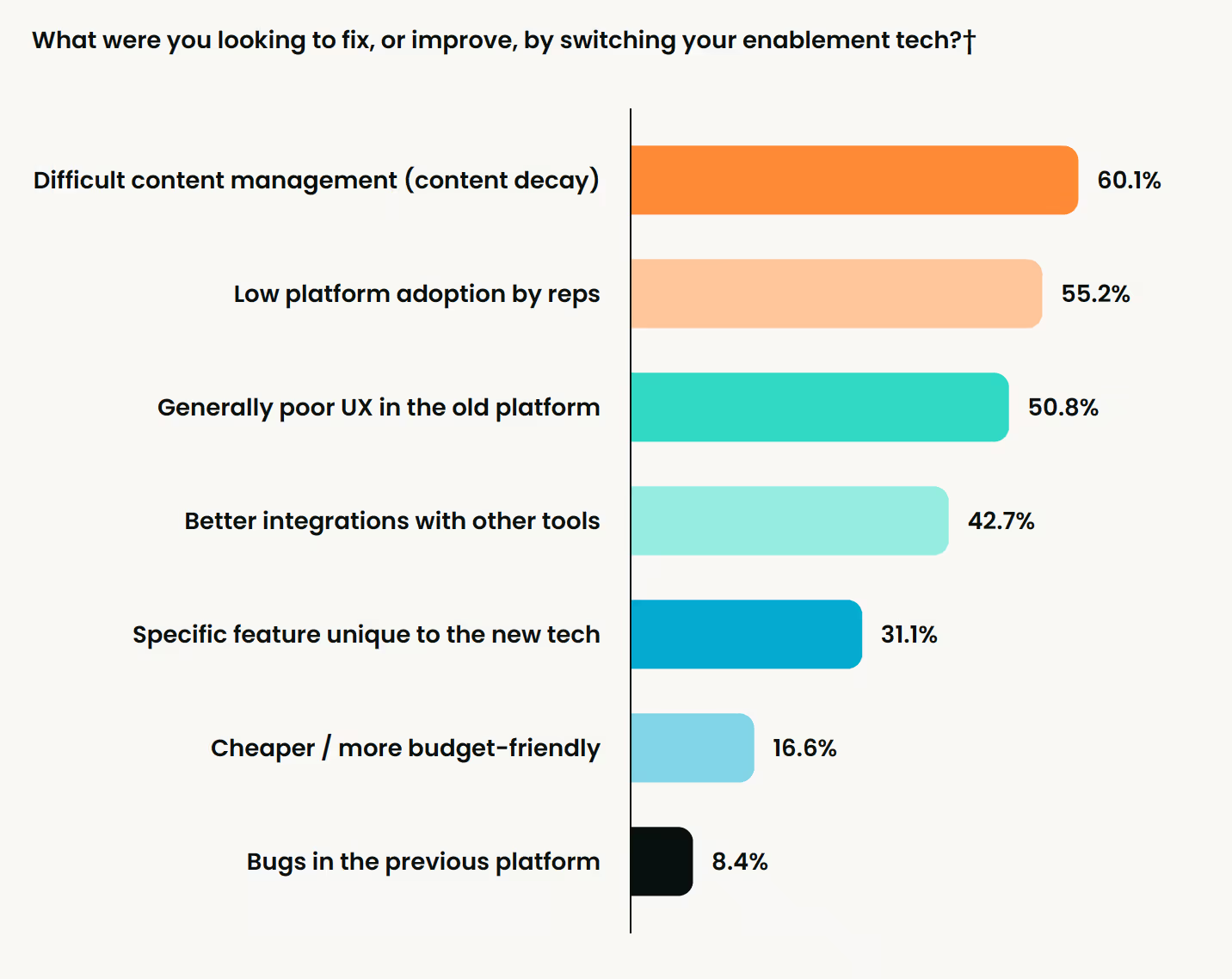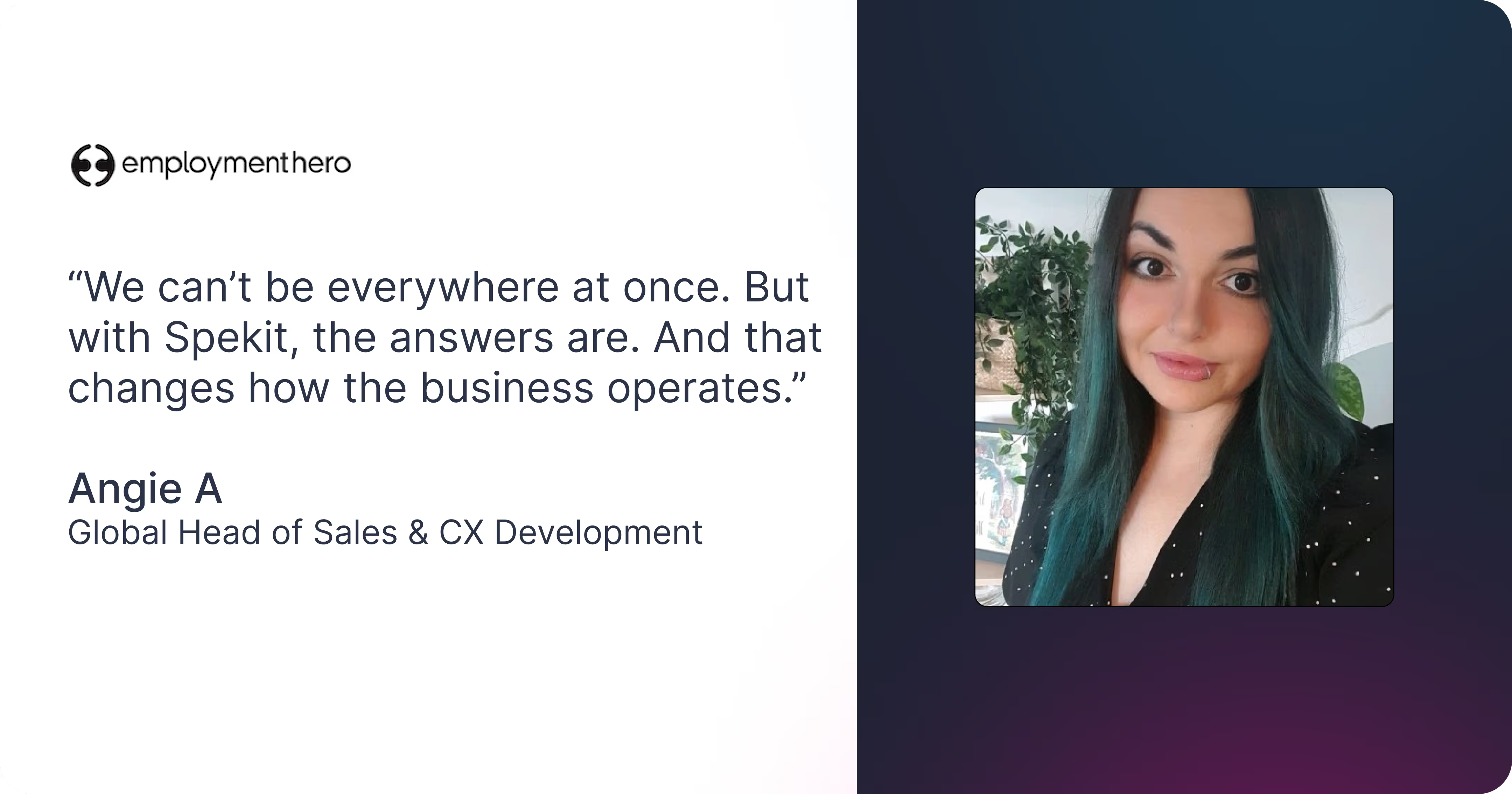Introduction: The Acceleration of AI and What It Means for Enablement
The past quarter has felt like someone leaned on the fast-forward button. Google rolled out Gemini's personalized search enhancements, Microsoft Copilot pushed deeper into Office, and Slack rolled outfederated AI search, to name a few. Clearly AI is no longer a future concept; it's happening now, everywhere, and at an unprecedented pace.
This rapid evolution presents both opportunities and challenges. You likely feel the pressure to adopt AI-driven tools, often without a clear framework for evaluation. With limited resources and an overwhelming amount of options, how do you identify solutions that truly support your revenue teams, deliver measurable impact, and integrate seamlessly into your workflows?
The stakes are high. Poorly chosen tools can lead to wasted time, low adoption, content decay, and ultimately, a failure to realize ROI. Conversely, the right AI-enabled solutions can transform enablement from a reactive, fragmented function into a proactive, strategic growth engine.
This guide will help you understand what to look for, how to evaluate AI tools effectively, and why a human-centered, strategic approach is essential in this rapidly shifting landscape.
The Why: Why AI in Enablement Is No Longer Optional
The data and research in recent months is everywhere, underscoring the transformative potential of AI:
- Faster onboarding and ramp times: Teams that leverage AI-powered content management and in-app enablement have seen up to 25% faster ramp times, saving thousands of dollars and enabling reps to contribute to revenue sooner.
- Increased content relevance: Platforms that support real-time updates and AI-powered governance prevent content decay, ensuring reps always have access to the latest, most relevant information.
- Enhanced user experience: AI-powered search and contextual guidance reduce friction, making knowledge easily accessible in the flow of work, where reps need it most.
"Spekit has fundamentally transformed how we think about knowledge sharing and enablement," said Richard Thibault, Head of Revenue Enablement and Training at Q4. "With AI Sidekick and the ability to create custom deal rooms, we've moved beyond siloed departments and static training. Now, every team member has instant access to the right information, at the right time, directly in their workflow. This is how we empower teams to close deals faster and work smarter."
The Risks of Inaction
Yet, most of us still face challenges:
- Fragmented tech stacks that create silos and hinder adoption.
- Limited understanding of AI’s capabilities and limitations, leading to misaligned expectations.
- Overcomplication and poor user interfaces that discourage usage.
- Security and IT concerns that slow or block deployment.
The key is to approach AI evaluation thoughtfully, focusing on how these tools or featured support your reps’ real needs and goals.
What the Data Tells Us: Lessons from Recent Reports & Industry Insights
Content Is Still King
The 2025 Impact of Enablement Report highlights that content management and user experience are primary drivers of platform success or failure. Over 60% of teams abandoned platforms due to content decay or poor UX.

AI can help by:
- Automating content updates and personalization.
- Delivering answers contextually, embedded directly into workflows.
- Reducing manual content curation, saving time and ensuring relevance.
Adoption & Engagement Matter
The same report shows that 86% of enablement leaders say at least 40% of the customer-facing content they create is never shared with buyers.
At least 40% of enablement content is never shared with buyers!
Traditional platforms bury content and functionality in disconnected in portals no one opens. For AI to be adopted and impactful, it must be just-in-time, serving the exact asset or play inside Salesforce, Slack, or Gmail, so reps actually use it, content earns its keep, and revenue teams see engagement (and pipeline) rise instead of rot.
Effective AI tools are intuitive, accessible, and seamlessly integrated, making adoption natural rather than forced.
Analytics & Impact Measurement
Understanding what content and guidance truly move the needle is crucial. Analytics that track usage, engagement, and business outcomes empower enablement teams to iterate and improve continuously.
.avif)
The Challenge of Legacy Platforms
Many teams switch platforms because of frustrations with content decay, poor UX, and low adoption. The cost of switching in time and resources is high, but so is the cost of sticking with ineffective tools.
The most forward-thinking organizations evaluate AI solutions based on their ability to support seamless transition, ongoing optimization, and strategic scaling.
How to Evaluate AI-Enabled Enablement Solutions: A Practical Checklist
To navigate this landscape, here’s a strategic evaluation framework, a checklist to assess whether a platform aligns with your goals and supports sustainable, scalable enablement.
Download Your AI Enablement Evaluation Checklist ->
Why the Right Evaluation Matters
In an environment where AI features are rapidly evolving, and new solutions emerge weekly, a thoughtful evaluation process saves time, resources, and frustration. It’s about aligning technology with your strategic enablement goals, supporting people, processes, and business outcomes.
The Human-Centric Approach
Effective AI doesn’t just automate; it amplifies human expertise. The best solutions:
- Support intuitive, seamless interactions.
- Provide targeted, personalized content.
- Deliver actionable insights to coaches and leaders.

The Strategic Advantage
Companies that approach AI evaluation strategically, focusing on support, usability, and impact, are better positioned to unlock the full potential of their teams. They turn enablement from a cost center into a competitive advantage.
Final Thoughts: Embracing AI with Purpose and Clarity
As the AI landscape accelerates, the companies that succeed will be those that evaluate solutions thoughtfully, prioritize user experience and impact, and embed AI into the natural flow of work.
Whether you’re exploring a new platform or enhancing your existing tools, remember: the goal isn’t just to adopt AI, it’s to empower your teams, accelerate learning, and drive measurable business results.
“At a previous company, the SDR first-call readiness process took two months due to the complexity of the medical device industry. By implementing a just-in-time enablement tool, we reduced ramp time by over 50%, bringing it down to just four or five weeks. Instead of pulling reps into costly live tools training sessions, we integrated a change process directly into their workflow, saving hundreds of hours that would have otherwise been spent on unnecessary training. This approach resulted in a significant ROI.” - Aaron Clark, Revenue Enablement Manager at Aidoc
The Next Step
Stay informed, be proactive, and focus on solutions that support your teams where they work, not just where they sit. As AI continues to evolve, so too must your approach to enablement, grounded in human insights, operational impact, and a clear vision for the future.
In this fast-changing world, clarity and strategic evaluation are your best friends.
See how teams are stepping into the future with Spekit's AI-powered just-in-time enablement today ->







